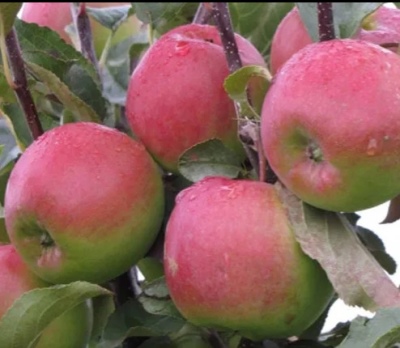
- Authors: Russia, VNIIGiSPR
- Taste: sweet and sour
- Fruit weight, g: 160
- Yield: up to 15 kg per tree
- The beginning of fruiting varieties: for 3-5 years
- Ripening terms: early winter
- Removable maturity: September 15-20
- Keeping quality: up to 2 months
- Appointment: universal
- Appeared when crossing: Prima x Bessemyanka Michurinskaya
Apple Bylina is one of the good Russian varieties. It is a purely fruiting plant that has no decorative value. Trees and their features are worth studying carefully.
Breeding history of the variety
The work on the apple tree was carried out by employees of VNIIGiSPR named after V.I. Michurin. Bessemyanka Michurinskaya and Prima were taken as a basis. The new variety was entered into the national register in 2005. It is officially zoned for the Central Black Earth Region.
Description of the variety
Features, pros and cons
Many gardeners are attracted by the early maturity of Epic. You can count on the first harvest as early as 3-5 years after planting. The height of the tree is not too high - 1.9 m. The plant is favored by its resistance to unfavorable natural factors. The fruits will be transportable.
The apples of the Epic are also distinguished by their impressive keeping quality. They can be used in a variety of ways, which speaks of the versatility of the variety. Not without its drawbacks. Among them, experts highlight the mandatory need for pollinating apple varieties. It is also noted that the number of fruits is critically dependent on the weather.
Ripening and fruiting
Bylinu is classified as an early winter apple tree. The first fruits can be harvested at 3-5 years of tree development. Removable maturity is reached in mid-September. Flowering begins in May. It is also necessary to take into account the meteorological nuances that can shift all these dates.
Growing regions
You can grow this variety successfully:
in the south of Russia;
in the areas of the middle lane;
in the western part of Russia.
Yield
For 1 tree of the Bylina variety, there can be up to 15 kg of apples. This is quite an average figure. However, it is stable due to its resistance to cold and other negative factors.
Fruits and their taste
The apples of the Epic are of the integumentary type. Almost all of their surface is red. The fruit itself is distinguished by an almost flawlessly regular shape. The shell is covered with a mass of green dots located under the skin. Fine-grained white pulp has a sweet and sour taste, tasting ratings range from 4.3 to 4.5 points.

Growing features
The Bylina variety has an average growth rate. It needs fertile, easily permeable soils. High moisture content of the soil is extremely important. It is necessary to choose a decently lit place, protected from the cold north wind. Preferred:
black soil;
loam;
sandy loam;
sod-podzolic land.




Frost resistance
This figure is very high. Even after a cold winter, bark and cambium are rarely damaged. Up to 3/5 of all flower buds are preserved. Therefore, there should not be any big problems in the cultivation of Epic in Russia. Only in the most difficult areas and in severely unfavorable weather will it be necessary to engage in covering work.

Diseases and pests
Scab is uncharacteristic for the variety. However, it can be affected by powdery mildew. Gradually, the dewy effect will be replaced by dark dots with a brown tide. You can suppress gray rot with a sulfur solution. Other diseases are also possible.
So, fruit rot is a very common pathology. If it does appear, then further spread is likely. You can suppress such a process using Bordeaux liquid. Another threat is subcutaneous spotting. Visually, it appears as characteristic dents; a similar problem is usually associated with a calcium deficiency.
With black cancers, the infection covers both apples and branches. Having found such an "aggressor", it is necessary to destroy him immediately. All deformed areas must be eliminated. All that remains must be treated with sulfur. Infection with late blight is likely with excess moisture; the problem is solved by draining the land, reducing watering and using special preparations.
Reviews
The small size of the Epic does not scare away many people, but only attracts. This circumstance further expands the scope of the use of culture. The number of fruits may not always please, but they are invariably tasty and pleasant. Scab resistance persists even if other varieties become ill. The appearance of apples is also to the taste of many.

The apple tree is a popular fruit crop among gardeners. It can be found in many summer cottages. But at the same time, such trees are often affected by various diseases. It is very important to recognize the disease in time and carry out the necessary procedures for a speedy recovery. Otherwise, the fruits will be spoiled, and the tree itself may die altogether.












































































